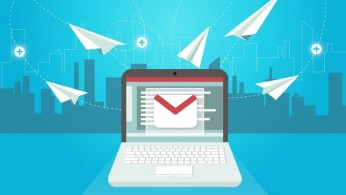| The key to running a successful business is enticing customers and clients to do business with you. So whether you’re scrambling to lure customers back during a global pandemic or expanding your markets during “normal” business times, the question is, How do you do that? What are the best ways to get customers to come to your store, website, restaurant, office, etc.? We all know the answer: it’s marketing. But marketing is not a simple process. There are various practices, tactics, and strategies that are part of an overall marketing plan—and they are constantly evolving. It can make formulating a marketing plan for your small business overwhelming. To help simplify the process, there is one marketing method that has maintained its claim to fame. Email marketing still promises to deliver the highest ROI of all marketing channels—$42 back for every dollar you spend. That’s not to say email as an industry, and your approach to it, isn’t evolving—it is, or it should be. As Tom Kulzer, CEO and founder of AWeber, a leading email marketing solution for small businesses, says, “The most effective [email] marketing strategies adapt, grow, and innovate.” AWeber recently released its 2020 Small Business Marketing Email Marketing Statistics Report, featuring insights from small business owners and industry experts. These are the techniques that are working for other small business owners. See if they’ll work for you as well. While email marketing can boast about its effective ROI, not all small businesses are using it. According to the report, 66% of businesses surveyed say they use email marketing to “promote their businesses or communicate with leads and/or customers.” Read more: Email Marketing: Still The Most Powerful Tool To Take Your Business To The Next Level |
| Companies have plenty of platforms at their disposal to get their messages to the masses, but email marketing is still one of the most crucial. Emails are a reliable, affordable and efficient way to reach prospects of all types, regardless of their position in the customer journey. To be effective, electronic communications must be deliberate, thought-provoking, and relevant without being overly intrusive or spammy. Email blasts are a commonly used type of content marketing and can be extremely engaging (or irritating, if executed poorly). When planned carefully, these campaigns can provide great ROI (return on investment) without alienating your audience. If you want to learn how to send a compelling email blast to your subscriber base, this guide will set you up for success. What is an email blast? An email blast is a stand-alone email message that you send to your entire contact list, or at least several segments. The goal is to reach as wide of an audience as possible with minimal investment on the front end. Also known as broadcast emails, bulk emails, or mass emails, email blasts are usually independent of targeted campaigns and more urgent in nature. The message within an email blast is usually promotional, such as enticing news about a sale or special. Email newsletters typically fall into the e-blast category as well. Email blasts may also include important news or unexpected updates that you need to communicate quickly. While seemingly innocuous, e-blasts get a bad reputation when executed poorly, so it is important to use them properly. Read more: How to Send an Email Blast (With Examples) |
| It’s true that talks about the demise of email marketing have been going on for quite some time. “Social media is taking over”, “other marketing channels are more efficient” and numerous similar myths have been circling around. The reality however is different! Nobody is pulling the plug on email just yet. Despite the obvious rise of social media in our everyday lives, people still receive emails in their inboxes and they expect it more than ever. The email remains the “king” among digital marketing channels driving a tremendous ROI for businesses. What seems to be dead (or obsolete, to be exact) are the strategies used and the email marketing methodology followed by some businesses! THE TRUTH ABOUT EMAIL MARKETING While email marketing is not something new, it’s still alive and kicking and far from dead according to the numbers. Specifically, according to recent statistics, email is an integral part of our daily online life. The number of global e-mail users in 2020 amounted to four billion and that number is expected to grow to 4.6 billion users in 2025. To put things into perspective, 3.6 billion people used social media in 2020. So, there are more people using email than social media. What’s even more interesting is the fact that the trend towards mobile devices has also affected emails, and almost 50% of total email opens occurred through mobile devices. So, people can effortlessly check their email even away from their PCs. As for the email’s effectiveness as a channel, 47% of marketers agreed that it is the most effective marketing channel, followed by social media marketing (39%), SEO (33%), and content marketing (33%). What’s also changed throughout the years is the affordability and functionality of email marketing services. The market is now full with robust tools with advanced features, while their pricing is affordable even for start-ups and small businesses. Some of the top email newsletter software right now can be found here. Read more: Email Marketing Isn’t Dead, but Old Practices Have Become Obsolete |
In the coming months, businesses are going to become more reliant than ever on their digital strategy. Without wanting to sound too alarmist, in many cases it will be the deciding factor in whether they make it through the tough times ahead.
The unprecedented, almost-total disappearance of all channels related to live events and conferences, and the increasing barriers on face-to-face business, pose an enormous challenge. Key to resilience is the development of ongoing contingencies to mitigate against this loss.
B2B companies in particular rely on the annual circuit of trade shows and exhibitions to network and build customer relations. In industries that are not digital-native, they may also be less sophisticated in their digital growth and customer relations strategies. For smaller businesses especially, used to getting new customers through word-of-mouth referrals or on the strength of a hard-won reputation, their loss is coming as a shock.
Larger companies are also now finding themselves in the position of having potentially lost millions through cancelled events. They won’t claw back the hours of time and expense spent on preparations for this year, but insurance and flexible cancellation policies will leave them with marketing budget to reassign. Digital is likely to be the clear winner here, and companies – including ones that may not so much as had a Facebook page before – will need to move into social marketing, content marketing, SEO and influencer-led campaigns.
Of course, this means there’s opportunities out there for the taking, if you are a B2B supplier in an industry that has been slow to adapt to digital marketing. A key factor in resilience is adaptability. If it’s standard in your industry to go out and meet new customers face-to-face before you do business, adapting may mean opening new channels over web or social media platforms where introductions can be made and relationships fostered. In the coming months, your prospective clients are going to be less open to the idea of letting you walk through the door and shake their hand – and no-one really has any idea how long this will last and whether this will lead to longer-term change.
As Scott Jones, CEO of 123 Internet Group, told me “We are in uncertain times, but with the increase of remote working and a collaborative approach, companies are turning to digital channels and embracing the transformation. We have seen a real spike during the last few weeks from companies wishing to create or update websites, launch new e-commerce channels and create social media campaigns focused on home-workers and a real focus on using influencers and SEO to reach new audiences.”
Being confined to the office – or even the home – rather than on the road on sales visits or at events, means marketers have more time to develop digital strategies. This means researching where your customers can be found online, and how different approaches and tactics might impact your success. If your organization previously put token efforts into digital channels – because like a lot of other businesses, you had built your networks offline and that had always seemed to work – now is the time to revisit them. That could be as simple as giving your website and social pages a refresh, or a more innovative approach.
Ratnesh Singh, head of global business at events technology agency Buzznation told me that he found out quickly that clients did not want to lose the networking opportunities provided by the conference circuit. On top of this, they are looking for new ways to spend their remaining marketing budgets. He said, “With our corporate clients, events often consume 50 to 60 per cent of their marketing budgets. They still want to spend that money and they are open to trying something new.
“There’s a window of opportunity here – when things are back to normal budgets will be going back into live events and that’s what they will be spending their time on.
“But if they see the benefits and opportunities that digital channels can offer, this will become part of their long-term marketing contingency plans.”
As well as offering immersive 3D virtual events, Buzznation has also found that businesses wanting to become more sophisticated in their use of live social platforms. Singh said “Clients are turning to Facebook or LinkedIn Live. Often these are platforms they have dabbled with in the past but never fully integrated into their marketing strategy. Now they see value in partnering with companies like us that know how to help them make the most of these channels, to achieve better production values and more targeted campaigns.”
It’s certainly true that the coming weeks, or months – or however long this situation lasts – will be a challenging time for any company that isn’t ready to think about how they will replace the opportunities that have been lost.
As long as businesses approach the shift to digital marketing strategically, there’s no reason why it should just serve as an emergency fill-in, but could carry on providing long-term value when the world eventually gets back to normal. And of course, it would make companies more resilient to deal with any future pandemics.
Digital marketing specialists, also known as digital marketers, which some also refer to as online managers, play a vital role in the development of a country’s economy because every company must have marketers, sales executives and business developers. These groups of executives are like the heart of a business. As the world is moving fast digitally, the duties of business development, sales and marketing gradually shift into digital marketing. Most people think that digital marketing is just about managing social media, but that idea is completely wrong. Digital marketing requires a strategy that will encompass all the online assets of a company and creating a brand story that will pull target audience.
Many people have got their hands burnt because of some so-called digital marketers. These are people who just collect money from individuals and organisations and promise things they cannot achieve, thereby failing. When this happens, distrust sets in and one begins to wonder if digital marketing is not another fraud.
The soreness of digital marketing comes from the inability of prospective clients to have trust in using digital experts because of their experiences. What we the real digital marketing experts and agencies are doing is to ensure the delivery of maximum result and educating the public on the importance of digital marketing. We are creating more avenues for people to learn and understand the great wealth and opportunities embedded in digital marketing as well as the great impact it can have on our economy.
Can you give an insight into the functions of digital marketers in a modern society?
A digital marketing manager is responsible for developing, implementing and managing marketing campaigns that promote a company and its products and/or services. He or she plays a major role in enhancing brand awareness within the digital space as well as driving website traffic and acquiring leads/customers. A digital marketer may also be responsible for managing the online presence and brand of a company. Social networking tools such as Facebook, Twitter, and Instagram allow businesses to engage with their consumers in real time and a digital marketer will often be responsible for this communication. He or she plays a major role in enhancing brand awareness within the digital space as well as driving website traffic and acquiring leads/customers.
Read more: Digital marketing beyond just managing social media accounts
There are two main components of search engine optimization (SEO): on-site and off-site optimization. With on-site optimization, you’ll be improving your site’s layout and performance, producing high-quality content, and targeting specific keywords that are relevant to your business and your audience. With off-site optimization, you’ll be posting content on external publications and building inbound links to your website.
However, there are peripheral ways to complement and enhance these efforts; for example, you can use social media to increase the popularity of your content and earn more links as a result of that increased visibility. Similarly, you can harness the power of email marketing to support and improve your campaign.
Here’s how.
Primary Goals
These primary goals are ways for your email marketing campaign to directly influence factors that have significant bearing on your rankings in search engines:
- Inbound links. The more links you have pointing to your site, and the more diverse and high-authority sources that are hosting them, the higher your domain authority will be. Domain authority, according to Moz, “is a score (on a 100-point scale) developed by Moz that predicts how well a website will rank on search engines.” As such, acquiring strong inbound links is a crucial factor in improving your SEO. You can use your email marketing campaign to specifically encourage other users to link to your latest posts, or specific pages of your site. For example, let’s say you’ve recently published a whitepaper with a truckload of important statistics you’ve gained from conducting original research. Getting this information in the hands of other users will make them more likely to link to it in the future.
- Content promotion. You can also user your email marketing campaign to increase the visibility and performance of your content in general. For example, you can send a weekly or monthly newsletter that recaps some of your blog’s most popular posts. This increases both the visibility of these posts (potentially leading to more inbound links) as well as general traffic to your site.
- On-site engagement. Google uses a plethora of individual traffic and engagement metrics to determine the relative “value” of a given webpage. Though the exact significance and influence of these metrics is often debated, it’s clear that having more active, engaged users (with lower bounce rates, higher time spent on page, etc.) is better for your search rankings. Keeping your email audience engaged and coming back to your site with valuable offers can help you maintain a more engaged overall audience.
Read more: How To Use Email Marketing To Boost Your SEO
It’s time to start rockin’ around the email tree. With the holidays fast approaching, businesses should start thinking about using marketing automation to get registers ringing.
This year, make the process easier with email marketing and automation. Rather than creating and sending emails during the thick of the holiday season, use marketing automation features to create relevant campaigns to arrive in subscribers’ inboxes at exactly the right time, all season long.
For most businesses, the last two months of sales account for forty percent of the total revenue earned throughout the year. With so much riding on the holiday season, using marketing automation is a decision even the Grinch wouldn’t disagree with.
To help businesses get their marketing automation groove on, we’ll give you a list of holiday emails that you can send and provide tips to get the most out of your marketing automation during this critical time of year.
Light up inboxes with these 4 automated emails
Wondering what emails you can automate this holiday season? Here’s a list of four emails that will light up inboxes:
1. A welcome email or series
2. Black Friday or Cyber Monday deals
3. An inspiring gift guide
4. Helpful holiday hints
Read more: How To Leverage Marketing Automation For Holiday Email Marketing
Email is easily the most ubiquitous digital communication technology. Ninety-five percent of online consumers have at least one email address and most check their email every day. If you are not incorporating this valuable tool into your real estate marketing, you are missing out on valuable leads. Here are a few items that make email so important and ways you can leverage it for marketing success.
Emails transmit information that a phone call can’t. When you contact prospects by email, you can immediately send them photos of homes, information about the size and price of a property, and important information for the sale. Letting the home speak for itself can be far more persuasive than trying to verbally describe a listing that your client or prospect just has to see.
Most consumers prefer email. In surveys, consumers indicate that email is their preferred method of contact for commercial communications — and, it makes sense. Email can be scanned, allowing people to gather the gist of a marketing message in just a few seconds. Unlike phone calls, email is not time bound. You can send your messages and consumers can peruse them at a time that is convenient for them. Email provides a record. If your prospects want to review the stats on a property, it’s right there in their inbox when they want it.
Email provides a great return on your marketing investment. The average email marketing campaign provides a 4,300 percent return on investment. Email allows you to reach as many or as few prospects as you would like at a very low cost. By using this method regularly, you can significantly drop your customer acquisition costs and increase your real estate business net profits.
Read more: Why Email Marketing Must Be a Priority for Real Estate Agents
If you want to grow your business, you have to consider the role of email marketing in your promotional mix. It’s still one of the less expensive marketing vehicles to employ, and by following a few simple rules you can change your customers’ perceptions of your email (and your company), drive sales, and foster better relationships in the process. To get started, this column will talk about advanced opt-in options, newsletter dos and don’ts, and pairing your email with other marketing vehicles. Our next column continues the discussion by exploring educational offerings, email and online survey best practices, and how to engage your customers via email using loyalty programs and rewards.
Can You Go Beyond Simple Opt-In?
Most reputable companies ask for customer buy-in when they collect email addresses. Granted, to maximize opt-ins, your website might auto-check the box that says “Contact me about promotions and offers.” Hey, at least you’re giving customers a choice.
Opt-ins are good, but consider giving your customers a few specific options rather than one vague choice. You’ll want to keep your list of options short. After all, if you make customers think too much or take too much time, most will get bored and abandon the task. That said, I’m not recommending you include all of these; the list below is to get you thinking. Depending on the type of product or service you offer, not all will apply to you. For example, you can give customers the option to:
Read more: How to Use Email Marketing to Strengthen Business Relationships
Small businesses that are just getting off the ground likely won’t have large marketing budgets. Advertising campaigns and billboards are probably well down the road. But email marketing can be an effective and inexpensive way for small business owners to spread the word about what they have to offer. Here’s a look at some of the benefits.
Consider the Pros and Cons
There are positive and negative elements to email marketing. It’s more cost-effective than direct mail, for example, which can be significant in saving money on postage costs. It also gives small business owners a better idea of how their message is being received, as Chad Brooks writes for Business News Daily: “… Businesses can see which emails were received, which ones went to addresses that were no longer active, which ones were opened, which ones were deleted before they were read and which ones enticed clients to click through to the website and make a purchase.”
But there is a common complaint when it comes to email marketing, and it involves the dreaded word “spam.” As Brooks explains, “… Some consumers may consider the emails to be spam and hold it against a brand’s reputation. If customers feel they are being bombarded by unwanted emails from a business, they will be less likely to become new or repeat customers.”
Explore the Different Methods
There are several ways that a business can engage in email marketing. Newsletters, for example, are a way to reach customers on a regular basis. Emails can promote an upcoming sale, as Brooks writes, or be posed as an invitation for customers to attend an event. And “lead-nurturing” emails can “keep brands at the top of mind for prospective clients,” he says. “These emails are sent out regularly until a potential customer is converted into a paying customer.”
Read more: Email Marketing Can Give Small Businesses a Boost








